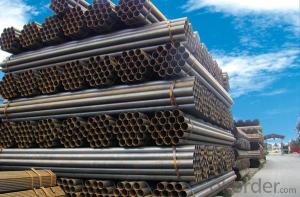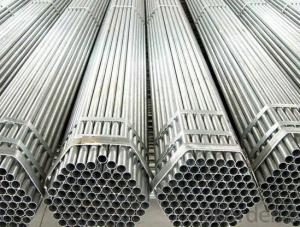Boiler Heat Exchange Stainless Steel Pipe
- Loading Port:
- Tianjin
- Payment Terms:
- TT OR LC
- Min Order Qty:
- 100 m.t.
- Supply Capability:
- 3000 m.t./month
OKorder Service Pledge
OKorder Financial Service
You Might Also Like
Product Description:
1、Structure of Boiler Heat Exchange Stainless Steel Pipe 31803 ASTM A213 Description:
Boiler Heat Exchange stainless steel pipe is often used in the heating system. Heating system, or those stored energy (such as solar energy) in the form of heat, need to be built with the material that can withstand temperatures up to 550 degrees Celsius. High chromium molybdenum welded steel pipe can work in the extreme, which maintain as the ideal material for the construction of power station.
2、Main Features of Boiler Heat Exchange Stainless Steel Pipe 31803 ASTM A213:
• High manufacturing accuracy
• High strength
• Small inertia resistance
• Strong heat dissipation ability
• Good visual effect
•Reasonable price
3、Boiler Heat Exchange Stainless Steel Pipe 31803 ASTM A213 Images:
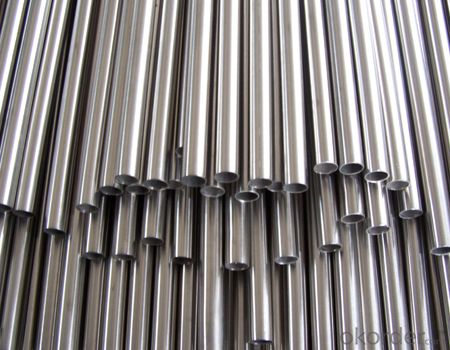
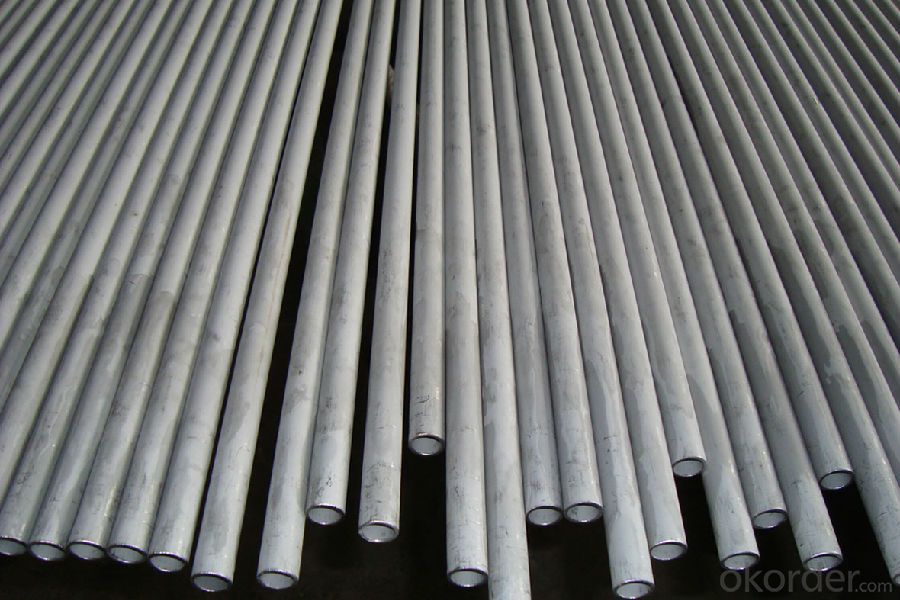
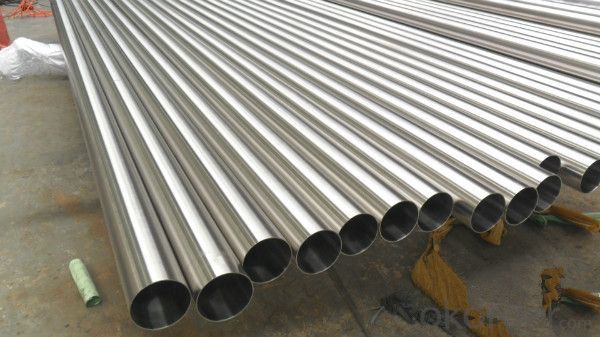
4、Boiler Heat Exchange Stainless Steel Pipe 31803 ASTM A213 Specification:
1)Commodity: heat exchanger pipe
2))Material: 304,316L,304L,316,321,310S,etc
3)Thickness:0.5-100mm
4)Length: 1-14m
| Material Grade | 304,304L,316 ,316L,321,310S,2205,904and so on. |
| Standard | ASTM A312, A554, A249, A269 and A270,ect |
| DIN 17456-85 , DIN 17458-85, DIN 17459-92,ect | |
| JIS G3446-1994, JIS G3448-1997, JIS G3459-1997, JIS G3463-1994,ect | |
| GB13296-1991, GB14975-2002, GB14976-2002,ect | |
| Outer Diameter | 13.7-2020mm |
| Thickness | 0.5-50mm |
| Length | 1m -12m or as customers' request |
| Polish | 180G, 320G, 400G Satin / Hairline |
| 400G, 500G, 600G or 800G Mirror finish | |
| Test | eddy current inspection, ultrasonic inspection, X-ray inspection, real-time imaging, hydrostatic test, spectral analysis, intergranular corrosion, water pressure test, and mechanical property testing facilities. |
| Payment | 1) by L/C at sight, |
| 2) 30% deposit, 70% balance before Shipping. | |
| Delivery time | A.7 days if this goods is stock goods. |
| B.25 days if this goods will be produced after order | |
| Validity | Valid time is 3 days for price usually. |
| Payment terms | FOB QINGDAO |
| MOQ | 1 ton |
| Capacity | 1000 ton per month |
| Certificate | ISO, SGS, and third part inspection |
| Applications | the products are widely used in chemical industry, condenser pipe, heat exchanger, petroleum, shipping military, environment protection, high temperature resistant, low temperature resistant, corrosion resistant and so on. |
| packing details | 1) Wooden-box Package. 2) The Wooden Frame Packing. 3) Intertexture Cloth Packaging with the Iron Sheet Bonding and the Two Terminals Covered With Plastic Dome. |
5、FAQ of Boiler Heat Exchange Stainless Steel Pipe 31803 ASTM A213:
①How is the quality of your products?
Our products are manufactured strictly according to national and internaional standard, and we take a test on every pipe before delivered out. If you want see our quality certifications and all kinds of testing report, please just ask us for it.
Guaranteed: If products’ quality don’t accord to discription as we give or the promise before you place order, we promise 100% refund.
②How about price?
Yes, we are factory and be able to give you lowest price below market one, and we have a policy that “ for saving time and absolutely honest business attitude, we quote as lowest as possible for any customer, and discount can be given according to quantity”,if you like bargain and factory price is not low enough as you think, just don’t waste your time.Please trust the quotation we would give you, it is professional one.
③Why should you chose us?
Chose happens because of quality, then price, We can give you both.Additionally, we can also offer professional products inquiry, products knowledge train(for agents), smooth goods delivery, exellent customer solution proposals.Our service formula: good quality+good price+good service=customer’s trust
SGS test is available, customer inspection before shipping is welcome, third party inspection is no problem.
Any question, pls feel free to contact us !
- Q: What are the categories of stainless steel pipes with acid and alkali resistance?
- Austenitic stainless steel is the stainless steel with austenite structure at normal temperature. When the steel containing Cr is about 18%, Ni, 8%~25% and C is about 0.1%, it has a stable austenite structure. Austenitic chromium nickel stainless steel includes the famous 18Cr-8Ni steel, and on this basis, increasing the content of Cr, Ni, and adding Mo, Cu, Si, Nb, Ti and other elements developed by the high Cr-Ni series steel. Non magnetic austenitic stainless steel with high toughness and plasticity, but the intensity is low, not through the phase change to strengthen, can only be strengthened by cold working, such as adding S, Ca, Se, Te and other elements, it has good machinability. Good comprehensive performance, corrosion resistant variety of media.To prevent intergranular corrosion, this kind of stainless steel is usually low carbon or ultra low carbon.
- Q: Can stainless steel pipes be insulated with polycaprolactone?
- Yes, stainless steel pipes can be insulated with polycaprolactone. Polycaprolactone is a versatile and flexible thermoplastic material that can be used for insulation purposes. It can provide effective thermal insulation to stainless steel pipes and help in reducing heat transfer and preventing condensation.
- Q: What is the difference between 304H and 316H stainless steel pipes?
- The main difference between 304H and 316H stainless steel pipes lies in their chemical composition and the elements they contain. 304H stainless steel is a variation of the 304 stainless steel alloy, specifically designed for high-temperature applications. It contains a higher carbon content than standard 304 stainless steel, which enhances its high-temperature strength and resistance to corrosion. This makes it suitable for use in environments where elevated temperatures and corrosive substances are present. On the other hand, 316H stainless steel is a variation of the 316 stainless steel alloy, also designed for high-temperature applications. It contains a higher carbon content than standard 316 stainless steel, similar to 304H, which improves its high-temperature strength. However, 316H stainless steel also contains molybdenum, which provides additional resistance to corrosion, specifically in environments with chlorides, such as seawater or marine applications. In summary, while both 304H and 316H stainless steel pipes are suitable for high-temperature applications, 316H offers better corrosion resistance due to the addition of molybdenum. The choice between the two depends on the specific requirements of the application, such as the presence of corrosive substances or chlorides in the environment.
- Q: Can stainless steel pipes be used for drinking water systems?
- Indeed, drinking water systems can utilize stainless steel pipes. Stainless steel, being an exceedingly durable and corrosion-resistant substance, is well-suited for deployment within plumbing systems. Furthermore, its non-reactive nature prevents the release of harmful chemicals into the water. Moreover, stainless steel pipes are effortlessly cleaned and maintained, thus minimizing the likelihood of bacterial proliferation and guaranteeing the safety and excellence of the drinking water.
- Q: What is the difference between Type 409 and Type 410 stainless steel pipes?
- Type 409 and Type 410 stainless steel pipes exhibit distinct characteristics and are used for different purposes. Type 409 stainless steel is a ferritic variant containing less chromium than Type 410. It is mainly composed of iron, carbon, and up to 11% chromium. This composition grants Type 409 stainless steel adequate resistance to corrosion in low-oxygen environments and moderate resistance to pitting and crevice corrosion. It finds common usage in applications where high-temperature oxidation resistance is unnecessary, such as automotive exhaust systems, catalytic converter shells, and heat exchangers. On the contrary, Type 410 stainless steel is a martensitic variant with a higher chromium content (around 11-13%) and a small amount of nickel. This composition endows Type 410 stainless steel with exceptional corrosion resistance and favorable mechanical properties. It is a versatile stainless steel that can be subjected to heat treatment to achieve elevated strength and hardness. Type 410 stainless steel is frequently employed in applications requiring corrosion resistance and/or wear resistance, including cutlery, surgical instruments, valves, and pump parts. To summarize, the primary distinction between Type 409 and Type 410 stainless steel pipes lies in their composition and resulting properties. Type 409 stainless steel is a ferritic variant with good corrosion resistance in low-oxygen environments, whereas Type 410 stainless steel is a martensitic variant with excellent corrosion resistance, heightened strength, and hardness. The choice between these two types of stainless steel pipes depends on the specific requirements of the application and the desired properties necessary for its success.
- Q: What is the maximum temperature limit for stainless steel pipes?
- The specific grade of stainless steel used determines the maximum temperature limit for stainless steel pipes. In general, stainless steel pipes can tolerate high temperatures ranging from 1200°F (650°C) to 1600°F (870°C). However, it is important to consider the specific alloy composition, as certain grades of stainless steel possess greater temperature resistance than others. Moreover, the maximum temperature limit can be influenced by factors such as the duration of exposure to high temperatures and the presence of corrosive substances. Therefore, consulting the manufacturer's specifications or seeking professional guidance is crucial to accurately determine the maximum temperature limit for a specific application of stainless steel pipes.
- Q: What is the difference between seamless and cold-rolled stainless steel pipes?
- Differences can be observed between seamless and cold-rolled stainless steel pipes in terms of their manufacturing process and resulting characteristics. Seamless stainless steel pipes are created by piercing a solid cylindrical billet of stainless steel and subjecting it to various steps, including elongation and reduction, to achieve the desired size and shape. Through this process, the pipe acquires a smooth and even surface without any welded seams. As a result, seamless stainless steel pipes exhibit superior strength, durability, and resistance to corrosion. Furthermore, they are capable of withstanding high pressure and temperature conditions, making them suitable for a wide range of applications, such as oil and gas pipelines, chemical processing, and power generation. On the other hand, cold-rolled stainless steel pipes are manufactured by rolling stainless steel sheets or strips at room temperature. This process involves passing the material through a series of rollers to reduce its thickness and shape it into a cylindrical form. Unlike seamless pipes, cold-rolled pipes possess visible welded seams on their surface. While these seams may potentially weaken the pipe, their strength and integrity can be improved by applying additional processes such as heat treatment or cold working. The choice between seamless and cold-rolled stainless steel pipes depends on the specific requirements of the application. Seamless pipes are generally preferred when high strength, corrosion resistance, and pressure resistance are crucial, especially in industries where leaks or failure can have severe consequences. On the other hand, cold-rolled pipes may be more suitable for applications where cost-effectiveness and moderate performance are sufficient, such as certain plumbing systems or decorative purposes. To summarize, seamless stainless steel pipes are manufactured without welded seams, offering superior strength, durability, and resistance to corrosion, making them ideal for demanding applications. Meanwhile, cold-rolled stainless steel pipes, which possess visible welded seams, are generally more cost-effective and suitable for less demanding applications that do not require the same level of strength and corrosion resistance.
- Q: Can stainless steel pipes be used for pharmaceutical storage tanks?
- Yes, stainless steel pipes can be used for pharmaceutical storage tanks. Stainless steel is a preferred material in the pharmaceutical industry due to its high corrosion resistance, durability, and ability to maintain cleanliness. It is non-reactive, which helps prevent contamination of the pharmaceutical products stored in the tanks. Stainless steel pipes also offer a smooth and easy-to-clean surface, making it suitable for maintaining the required hygiene standards in pharmaceutical storage. Additionally, stainless steel is resistant to extreme temperatures and can withstand the rigorous cleaning procedures commonly used in pharmaceutical facilities. Thus, stainless steel pipes are commonly used in the construction of pharmaceutical storage tanks to ensure the safety and integrity of the stored pharmaceutical products.
- Q: Can stainless steel pipes be used in the petrochemical industry?
- Indeed, the petrochemical industry can utilize stainless steel pipes. Due to its exceptional resistance to corrosion and ability to endure elevated temperatures, stainless steel emerges as a perfect option for the transportation and storage of diverse petrochemical goods. Moreover, its durability and strength render it apt for managing the frequently encountered high-pressure circumstances within the petrochemical industry. Furthermore, stainless steel pipes facilitate effortless cleaning and maintenance, guaranteeing the purity and soundness of the petrochemical products during transportation. As a result, stainless steel pipes find widespread application in petrochemical plants, refineries, and other related facilities.
- Q: How do you prevent discoloration in stainless steel pipes?
- To prevent discoloration in stainless steel pipes, there are several measures that can be taken: 1. Proper cleaning: Regularly clean the stainless steel pipes using mild soap or detergent and warm water. Avoid using harsh chemicals or abrasive cleaners that can damage the surface and cause discoloration. 2. Rinse thoroughly: After cleaning, make sure to rinse the pipes thoroughly with clean water to remove any residue or cleaning agents that may cause discoloration. 3. Avoid contact with corrosive substances: Keep stainless steel pipes away from direct contact with corrosive substances such as strong acids, alkaline solutions, or chlorides. These substances can lead to chemical reactions and cause discoloration. 4. Use protective coatings: Applying a protective coating, such as a clear lacquer or a special stainless steel protective spray, can help prevent discoloration by creating a barrier between the metal surface and the environment. 5. Control temperature: Excessive heat can cause discoloration in stainless steel pipes. It is important to control the temperature of the surrounding environment or the fluid passing through the pipes to prevent overheating. 6. Regular maintenance: Perform routine inspections and maintenance to identify any signs of discoloration or damage and address them promptly. This includes checking for leaks, corrosion, or any other factors that may contribute to discoloration. By following these preventive measures, you can significantly reduce the risk of discoloration in stainless steel pipes and maintain their aesthetic appeal and functionality for a longer period.
Send your message to us
Boiler Heat Exchange Stainless Steel Pipe
- Loading Port:
- Tianjin
- Payment Terms:
- TT OR LC
- Min Order Qty:
- 100 m.t.
- Supply Capability:
- 3000 m.t./month
OKorder Service Pledge
OKorder Financial Service
Similar products
Hot products
Hot Searches
Related keywords
















